History was made at Al Janoub Stadium. Australia beat Denmark 1-0 with a great goal from Matthew Leckie, qualifying for the first time to the Round of 16 of a World Cup since their presence in the 2006 tournament, where they advanced as second in the group and faced the future champions, Italy, where a goal by Totti from a penalty eliminated them at that moment. This time, they advance with six points, after their victories by just one goal against Tunisia and Denmark, already registering this squad in the history books of Australian football.
For the Denmark team, with their excellent previous performance in the UEFA Nations League, EURO 2020 and the 2018 World Cup where they began to show positive signs with Kasper Hjulmand, it is an absolutely brutal blow emotionally, as they will have to wait another four years to try to advance of the group stage, a phase that they were able to overcome on four occasions within their six participations in the competition. Given the growth of Danish football and its players in Europe’s top leagues, it’s a critical hit for such a talented squad.
In this tactical analysis, we dive into the tactics of both teams in form of analysis and see how Graham Arnold’s low block knocked out Denmark of the World Cup.
Lineups
Graham Arnold continued his 4-4-2 with ex-Brighton’s Mathew Ryan in goal, a defence made up of Aziz Behich at left-back, Harry Souttar and Kyle Rowles in the centre, plus Milos Degenek over on the right. The midfield consisted of Aaron Mooy and Jackson Irvine in the double pivot, with Matthew Leckie and Craig Goodwin on the wings, ending with Riley McGree and Mitchell Duke up front.
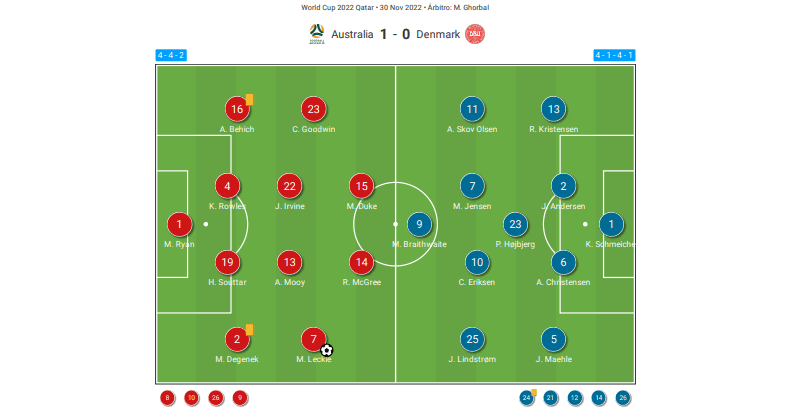
Kasper Hjulmand and his team were knocked out of the World Cup with a 4-3-3 formation that had Kasper Schmeichel in goal, Joakim Maehle as left-back, Andreas Christensen and Joachim Andersen as central defenders and Rasmus Kristensen as the right-back. Premier League trio, Mathias Jensen, Pierre Emile Hojbjerg and Christian Eriksen made up the middle. The attack was completed by Jesper Lindstrom, the UEFA Europa League champion with Frankfurt, Martin Braithwaite and Andreas Skov Olsen.
Australia’s solid mid-block and rapid transitions
The match unfolded as expected and as seen throughout the 2022 World Cup. Australia demonstrated in their first two games, to be a fairly compact and solid team in a mid-block. Beyond the 4-1 defeat against France, where their first 30 minutes were quite rigid, being 1-0 up and 1-1. Their game against Tunisia was much more solid and they showed that their counter-attacking football and idea worked. On the part of Denmark, more than the very same of those from Hjulmand. Extremely flat, with little freshness and dynamism between the lines when they had the ball.
Graham Arnold’s men set up a 4-4-2 thus looking to cover the passing line with the first midfielder, who rotated between Pierre Emile Hojbjerg and Mathias Jensen, which had few ideas and were rarely found as the first pass from their centre-backs. Further back, the two Australian midfielders and wingers closed the central spaces quite well where Eriksen or Jensen/Hojbjerg looked to appear higher, with these rotations depending on which one was dropping as a #6.
The front line of forwards kept quite a distance from Denmark’s two central defenders, Joachim Andersen and Andreas Christensen, who quickly ran out of answers, as Australia kept their lines so tight and man-marking on the wings that the Danish were stressed looking for solutions to break down the opponent’s lines.
This duo in attack and defence, kept the pivot closed in a numerical superiority who could not find the spaces to receive the ball, since the ball travelled little to the side to one of the full-backs and the passes to the middle were very dangerous, due to the strong marking that Australia produced when the ball was played from the back through the central lanes.
As we can see in the following figure, Australia with Mitchell Duke and Riley McGree as part of this defensive duo, closed Hojbjerg who was constantly moving from side to side, finding zero answers and going a long time without receiving, which exhausted him mentally and physically, as well as his teammates.
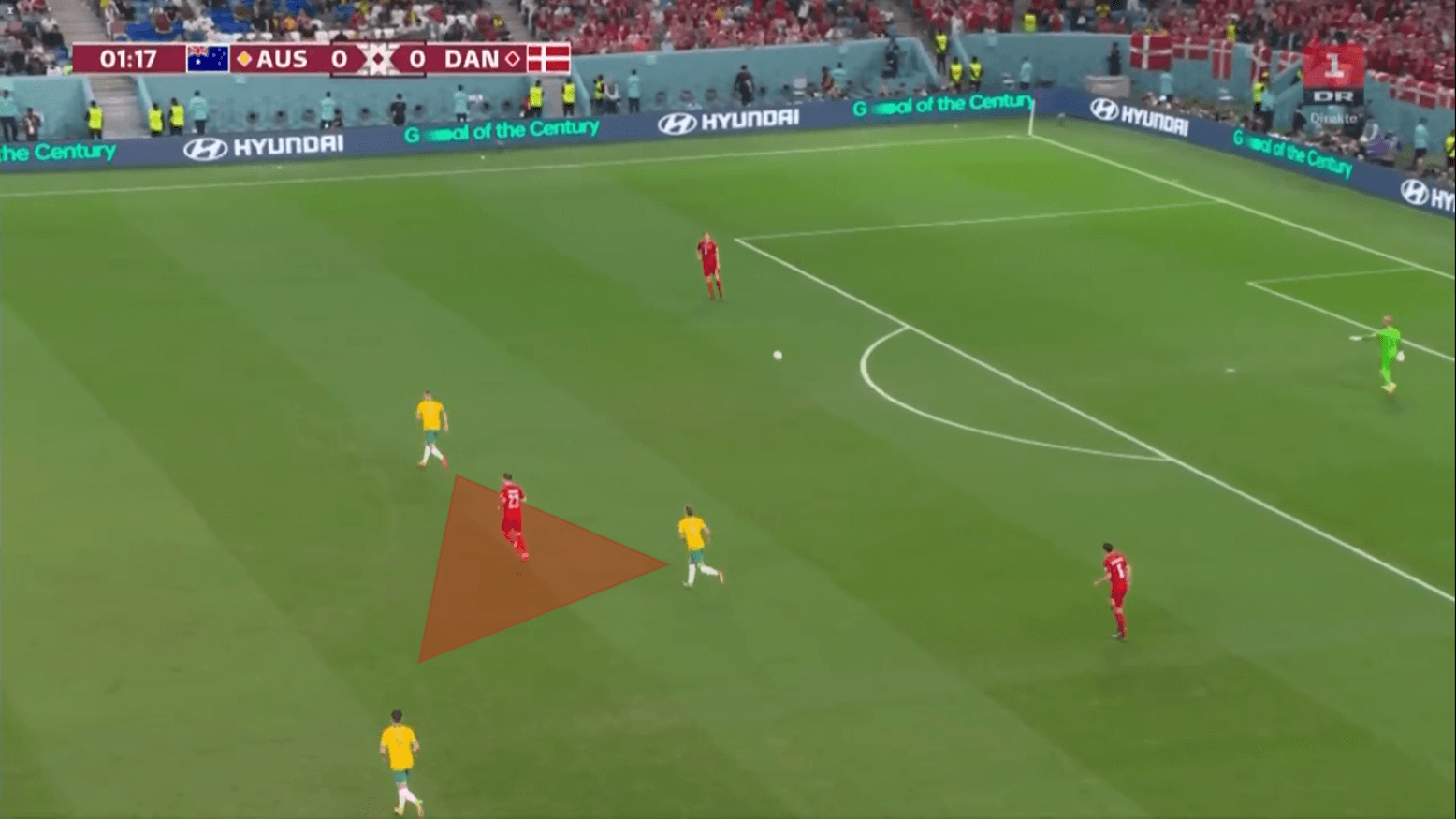
However, Denmark sought the game in different ways, one of them of course being through Eriksen’s technique and movements with Jensen trying to appear in half-spaces, where they could hurt the Australian block between the lines. But Arnold’s men closed all the possible passing options that were emerging for the Scandinavians while the match was going on.
With Mathias Jensen’s up and down movements, Denmark hoped to activate those half-spaces with the arrival of Eriksen or their inverted wingers. The three Danish midfielders normally kept very close together in these early stages of game development for their team, although at times they also distanced themselves. The idea was for them to accumulate centrally, so that the wide players could finally get in touch with the ball, like Maehle or Kristensen, who did not have much to do against the aggressive brand of their rival.
The Australian block as soon as the ball appeared behind the forward line was extremely aggressive, with persecutions from one of the four midfielders who received the ball. As we can see in the image below, Jensen executes the movements of descent-ascent, but Eriksen in this case is not close. Hojbjerg is closely marked by one of the Australians who jumps, and the double-forward is going to put a lot of pressure on Andersen, the central defender who was looking to launch diagonals if things weren’t quite as fresh and clear, as in this play.
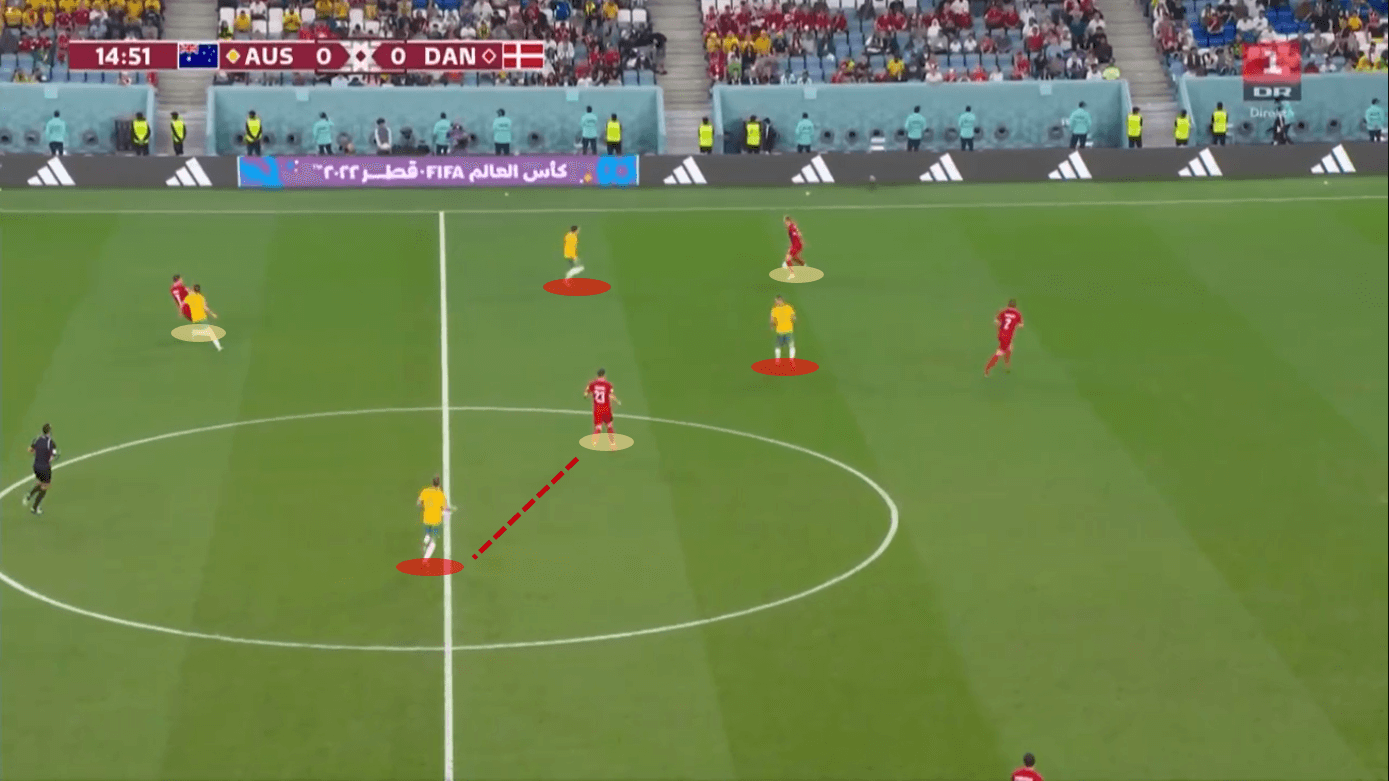
Normally, Australia constantly forced Kasper Hjulmand’s team to play balls to the wings, where they went to mark very aggressively, and something that was seen a lot during the match was how the Australians stole from the full-backs or even forced them into errors such as inside passes to a very congested central channel, where the midfielders won the ball back with great ease.
Jackson Irvine’s coverage to the side and between the midfielders was very good, in addition to having Aaron Mooy who always sat a little behind and made good supports if the distances covered by his teammate were long, something that did not usually happen since the block maintained by Graham Arnold’s men was very close in each of their lines. Almost never, the Europeans were able to generate 2v1 on the flank, as both Matthew Leckie and Craig Goodwin were very attentive to stop this, and the full-backs of the Australian team came out aggressively to not let the Danish wing-back receive comfortably, which played very high.
In this image, we can see the defensive coordination between them and the aggressive jumps of the full-back. One from the midfield line chased after one Danish ball-holder, consequently staying on top, and his teammates automatically formed a defensive 4-3-3 behind him. This generated rigidity and order that Denmark could not pass over and was forced to play outside where they were strongly pressured.
At times Denmark was able to progress if these full-back jumps were not well timed, because Australia accumulated a lot of people inside, and if they played outside and did not give the correct support there, they advanced. Or even changing with diagonals to the weak side of the ball.
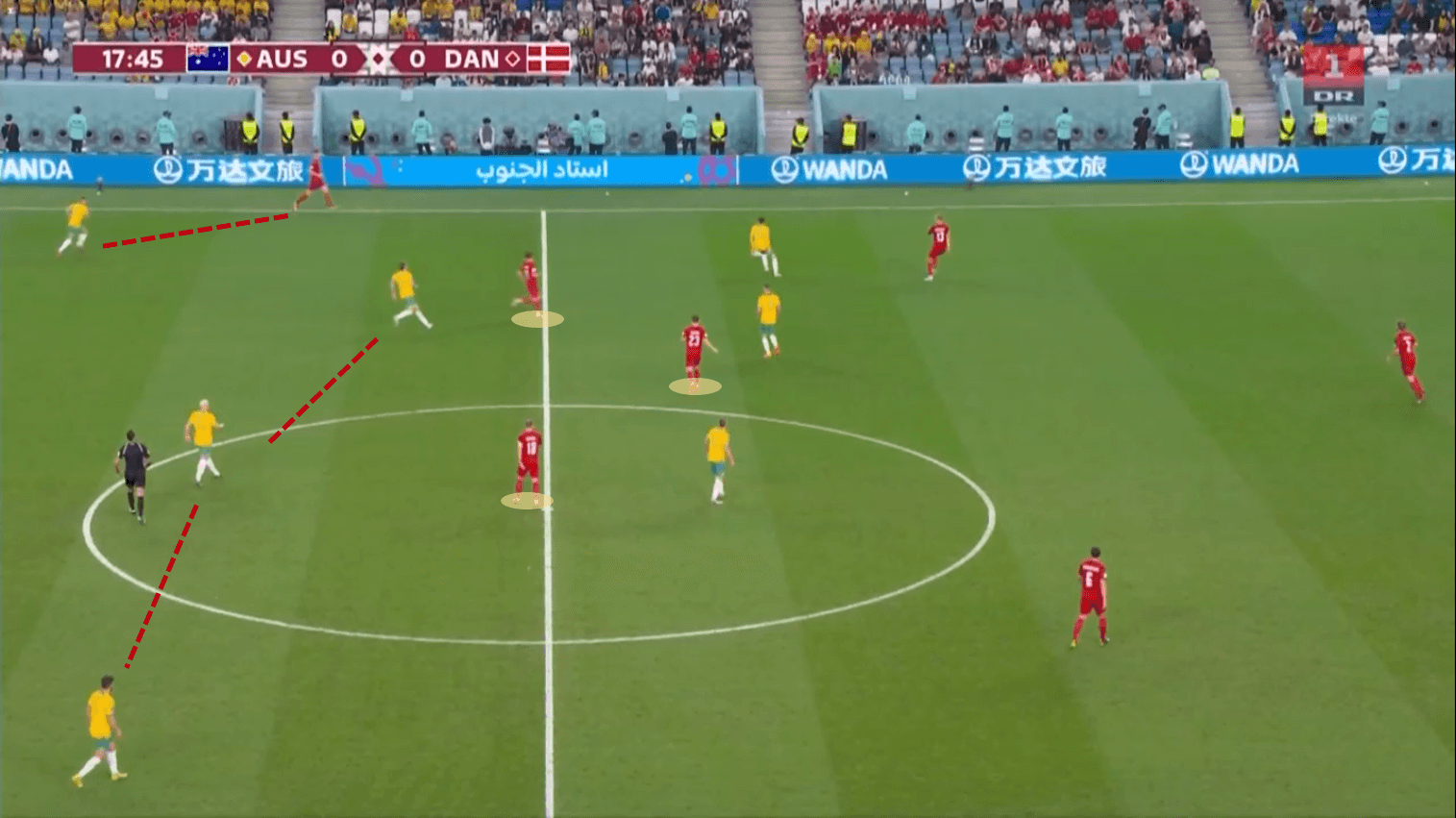
Denmark, in addition to the movements of their midfield to be close, or away at certain times trying to step on inner channels, also tried to move a little with a tactical adjustment to launch the full-backs as wing-backs, which happened during the whole game.
This was thanks to the relegations of Hojbjerg, Eriksen and Jensen, which were counterproductive as they were in an area where they could not develop dangerous play, and were forced to play diagonally long balls that could result in possession for Australia, after viewing that all the central road was locked by Arnold’s side.
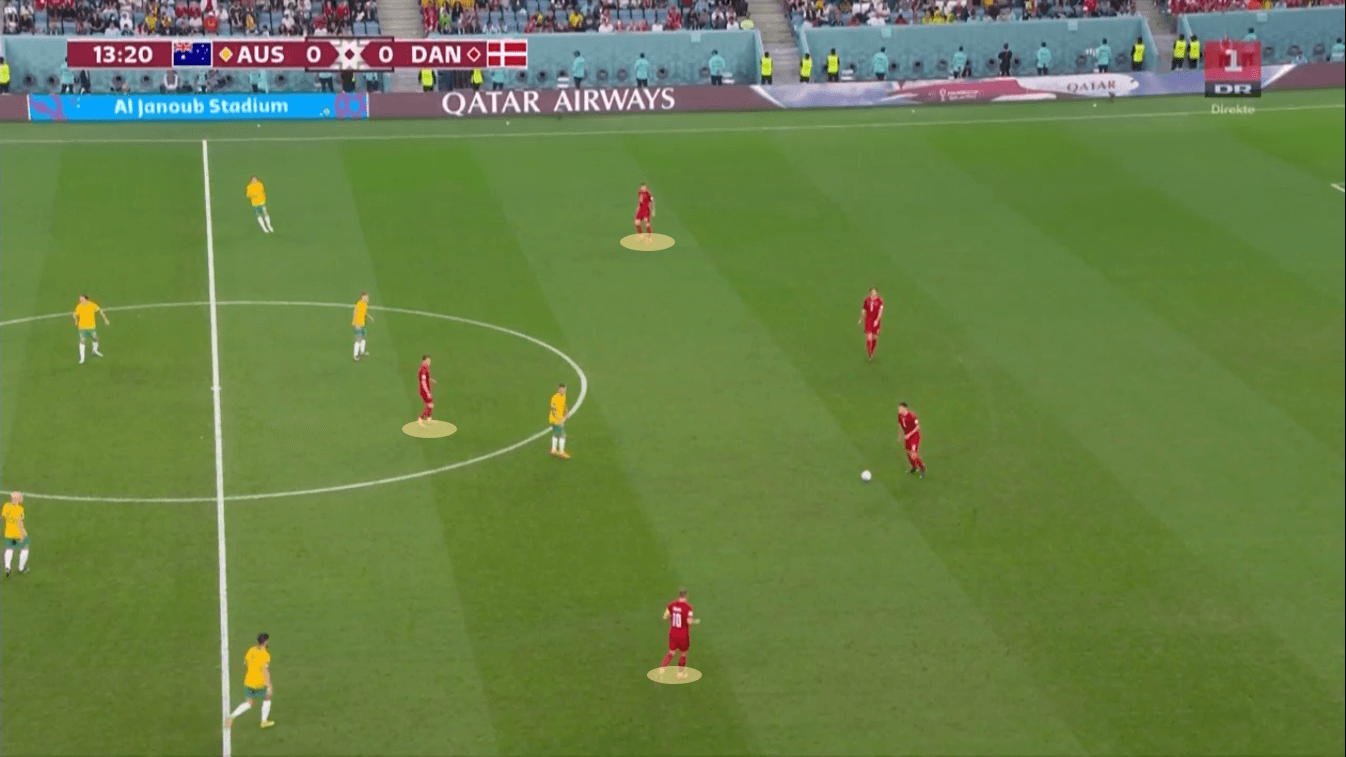
Sometimes attacked from inside to the wing where the timing of the full-backs was not correct, Graham Arnold corrected for the second half to defend in a 4-3-3, after the substitution of Keanu Baccus for Craig Goodwin. Jackson Irvine joined the offensive three, and Leckie was relegated as a midfielder in a midfield three. This was in order to try to be much more compact both up front and forward and create 3v2 numerical superiority against central defenders who were beginning to see spaces to progress with their good technique, like Andersen.
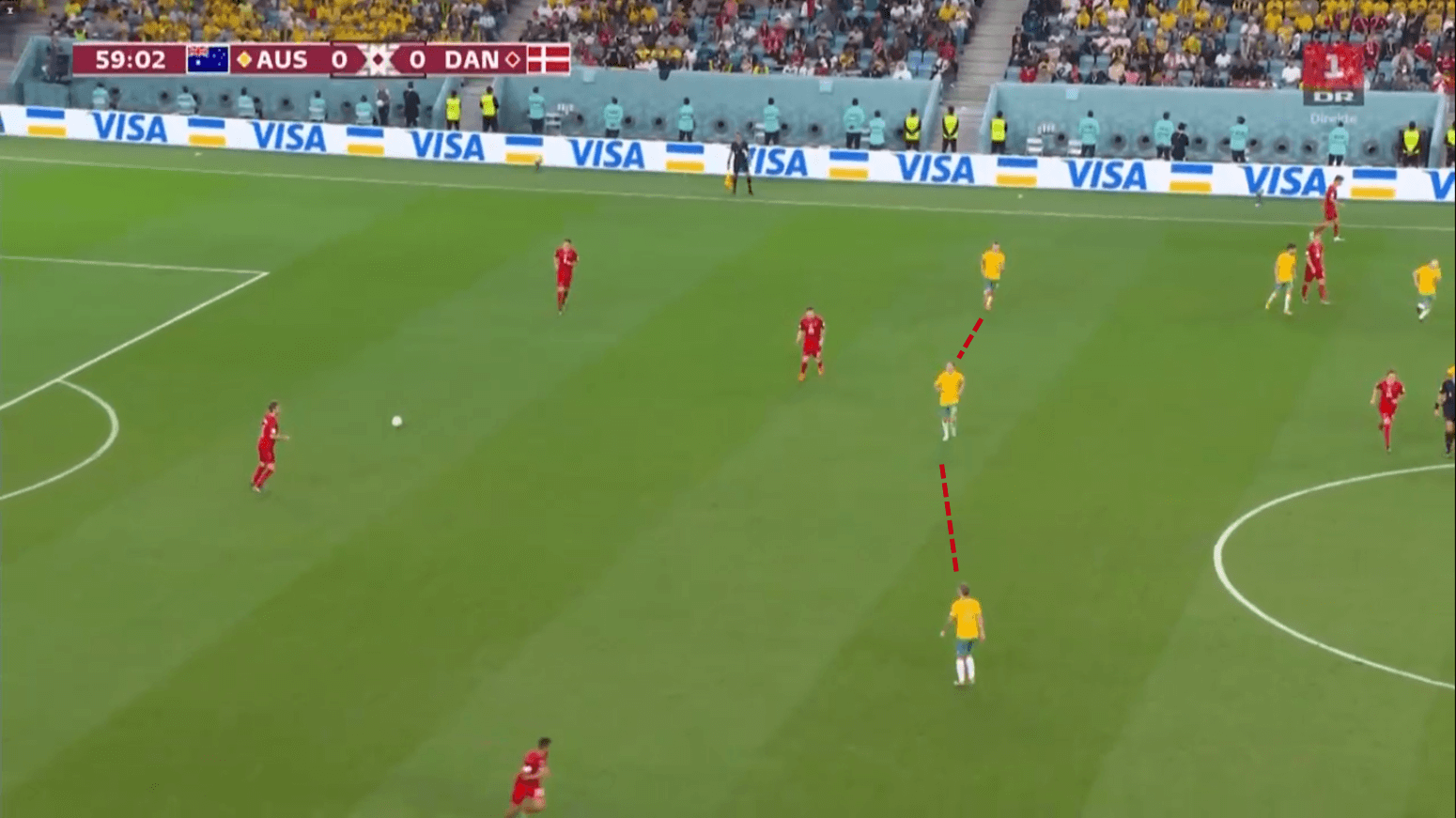
Australia’s way of attacking was really simple but difficult to execute since it comes from previous defensive actions that need great timing and concentration to win the ball and then command attacking transitions that must be carried out at great speed and then choose the best decision. This has already been the trademark of Graham Arnold’s team during this group stage, a team that is based on the counterattack.
This simplicity could be seen in several transitions that were normally commanded from within to the outside, in two or three touches from a midfielder to then release wide players with long passes, who were quickly drawing diagonals or running behind the opposing full-backs.
One of the requirements for creating plays from behind was to look for easy back-passes to the goalkeeper, Mathew Ryan so that he kicked extremely high and long balls to the flanks, or near this area of the pitch, where a winger could battle for the ball in a very physical 1v1, drag his mark tight and then unload the ball for the teammate in front of him. One of the most sought-after in this sense was Matthew Leckie, although there was also the participation of Mitchell Duke on the left, the team’s target man.
This move is a very clear example of what Australia was looking for. Leckie pinned a rival full-back, physically battled with him, lowered the ball to his feet and unloaded his teammate from the front, in this case, Aaron Mooy who was far away, but understood that he had to run close to him, and then, after the space created by attracting the Danish full-back, Mooy throw a long ball to Riley McGree who activated these spaces that were generated vastly during the match.
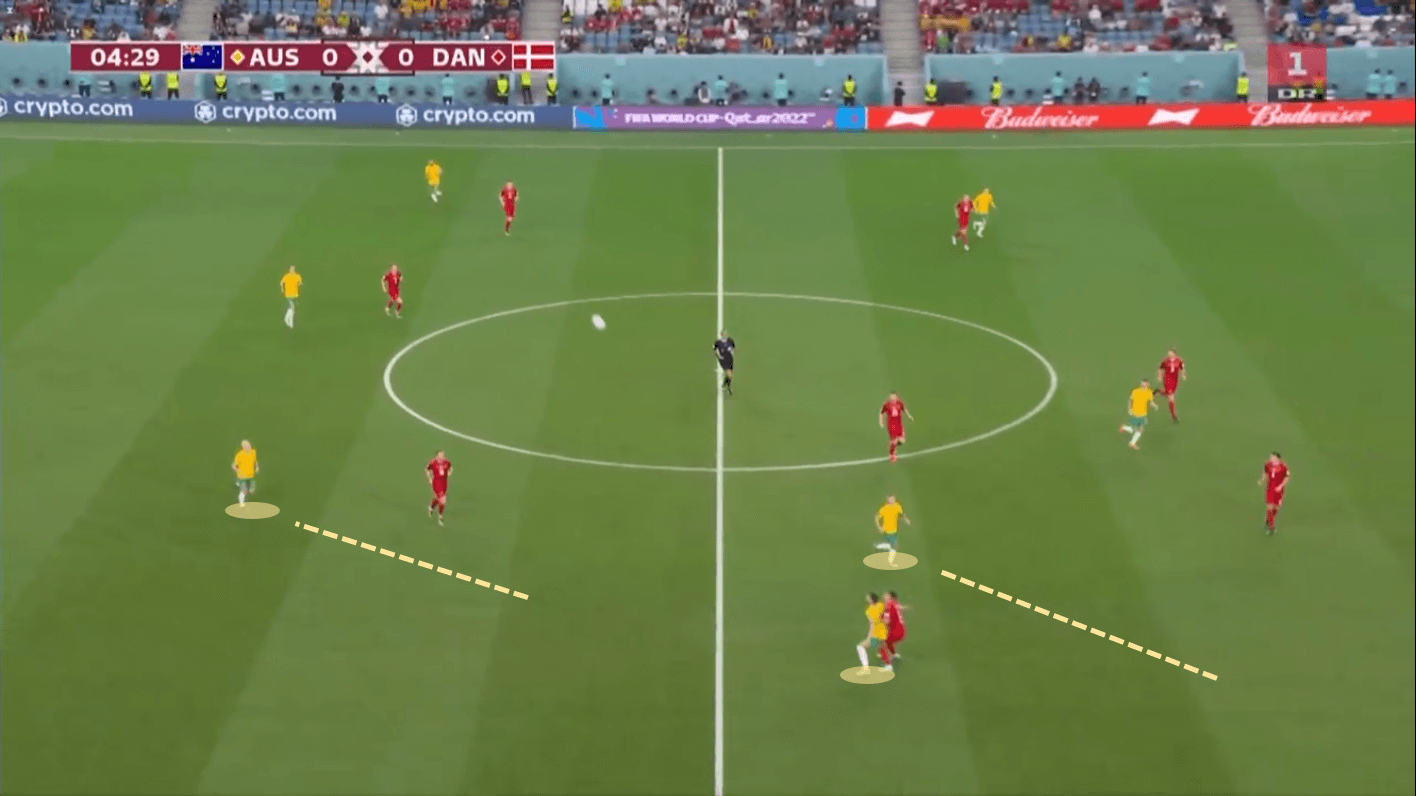
We can see another example of this where the play is even clearer in the picture. On this occasion, the pass was executed by the left centre-back, with a lower type of execution, almost at the foot of Mitchell Duke, who unloaded his teammate in front, and he then launched the long pass to the wide player who was instantly making the run in-behind the opposition full-back.
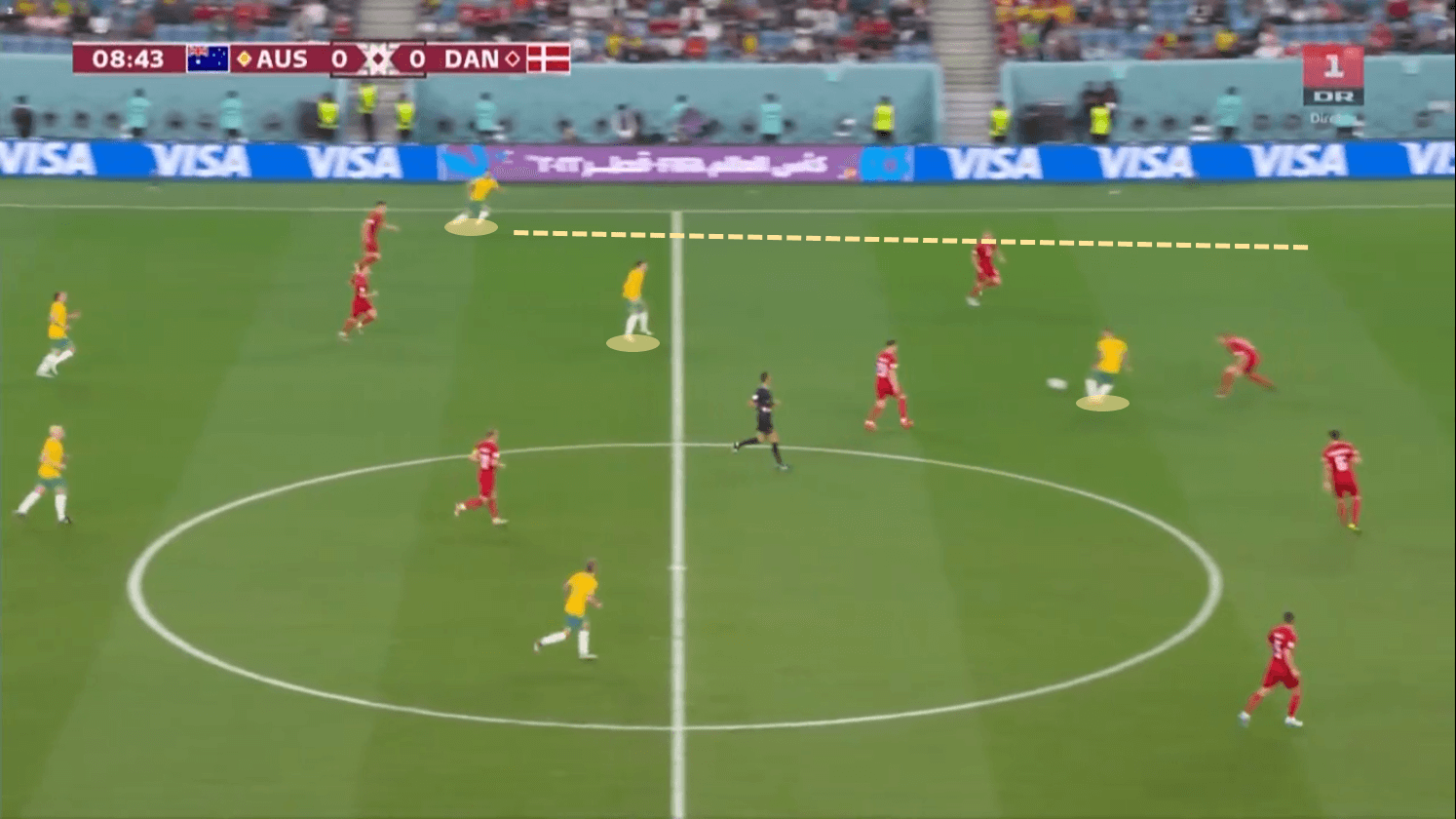
However, it was not the only way that the Australians found to execute transitions, they had several catalogues of how to do it in a game that at first had a Denmark, not that solid defending, but better than what it was in the second half where they received the goal that eliminated them from the tournament.
The attacking transitions for Australia started automatically after a loss of possession of the opponent. They didn’t wait long, after two or three touches, one of the players must already be throwing long balls at one of the players who traced the run to appear free into space.
One of these ways that Graham Arnold’s team executed it, was when they stole the ball on the wings, where they were defensively aggressive. After winning it back, the footballer who was in possession executed outswing passes to one of the forwards or wingers that were closing, running between the centre-backs or between centre-backs and full-backs.
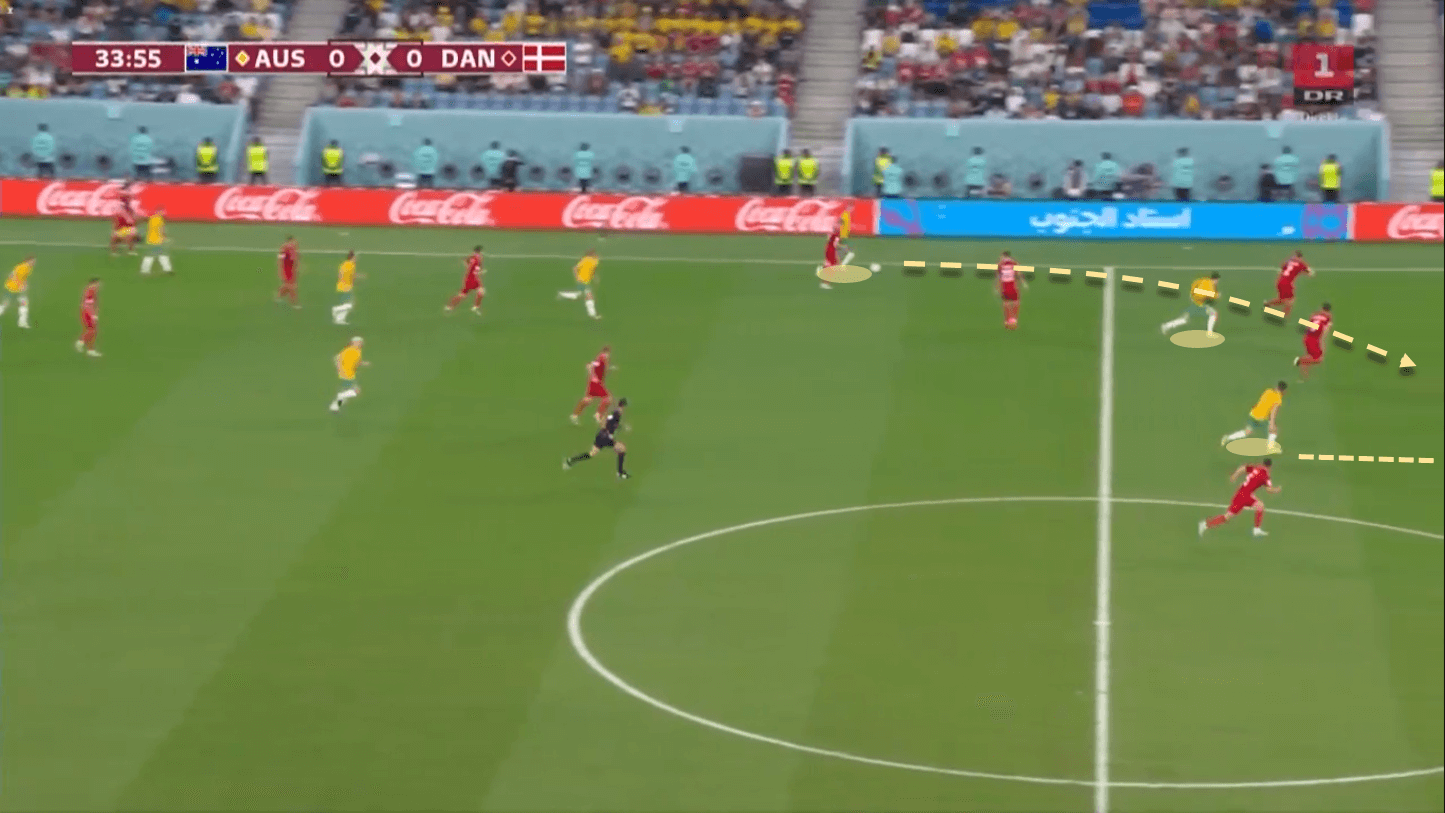
Even Matthew Leckie’s incredible goal which featured some pretty good dribbling beforehand by the former Bundesliga player Hertha Berlin scored in a big way to send his team to the knockout stages. The ball was received on the wing after a defensive corner, and after this reception, the delivery was executed as an outswing pass, thus freeing Leckie to run into space and score the qualifying goal. Outswing passes were the most sought-after by Australia, even from the middle, when players like Mooy received, sent this type of delivery.
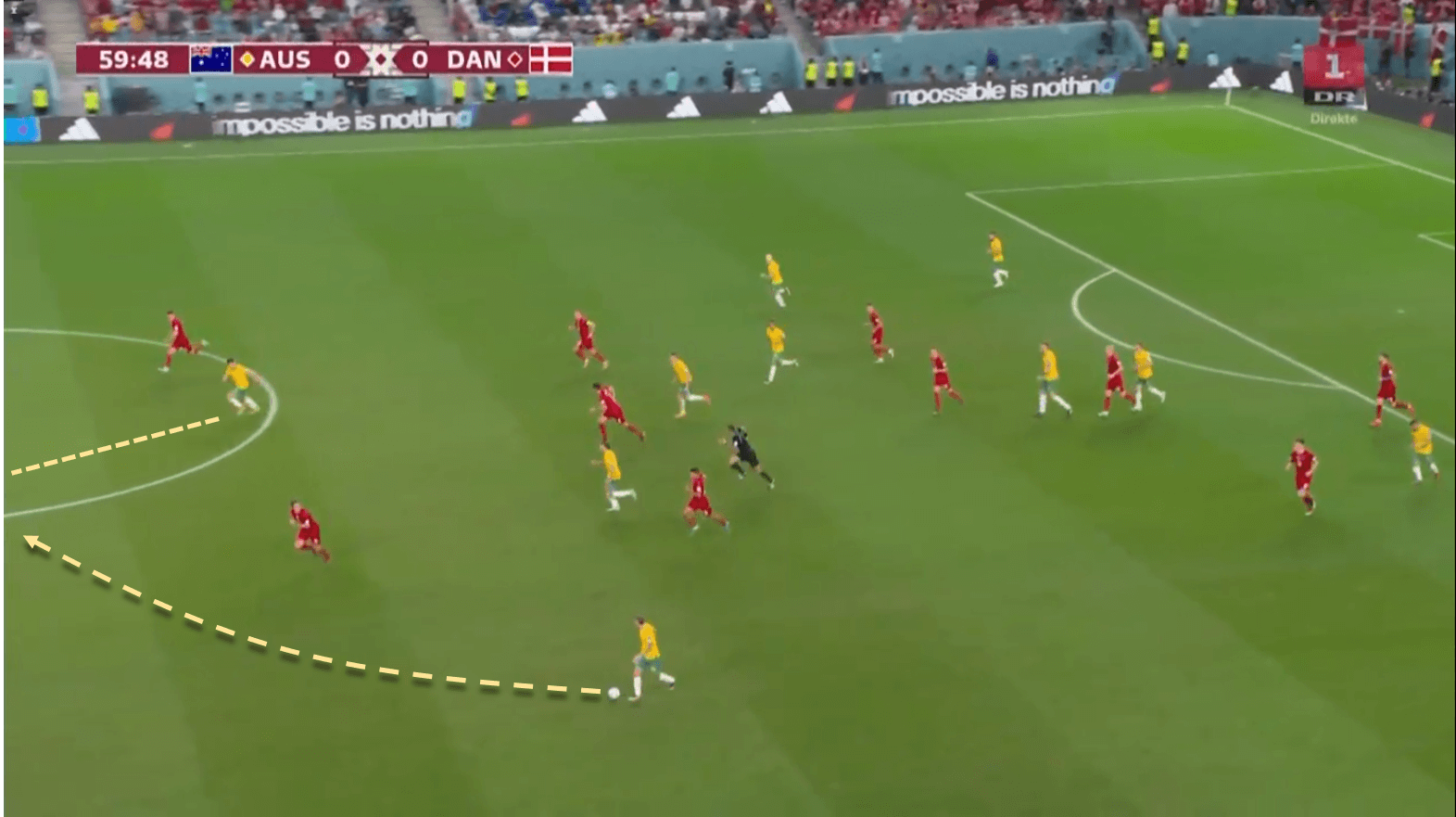
Australia was also identifiable by their way of attacking many players after winning possession. One of the midfielders joined in occasionally to attack the space, one of the forwards sought to attack the half-space with diagonals, another was more centralized, and on-the-wing runs were made behind the backs of the full-backs who were the weakness of Denmark in this match.
Almost five players on each transition were running to spaces trying to create new passing options for their teammates on the ball. Could be four or five at times, but it’s definitely a big number to take into account when defending.
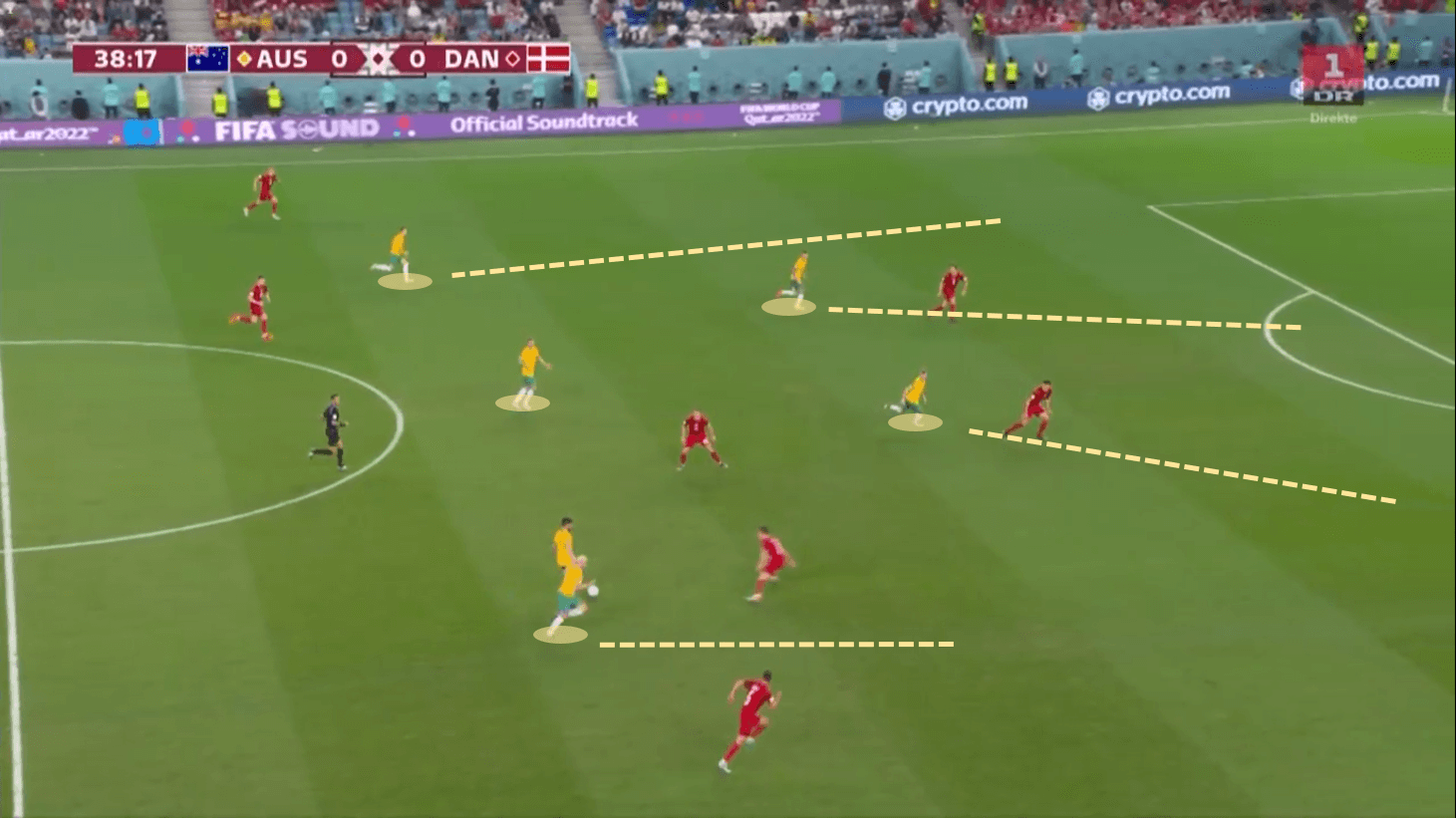
Conclusion
Australia was superior to Denmark with its more defensive but deadly counter-attacking game idea. With a tense last 30 minutes after the goal, centre-backs Harry Souttar and Kyle Rowles were on hand to save several times with their blocks Australia from elimination in those minutes. Argentina will have to face an opponent who is extremely physically strong and fast when playing through wide zones.






Comments